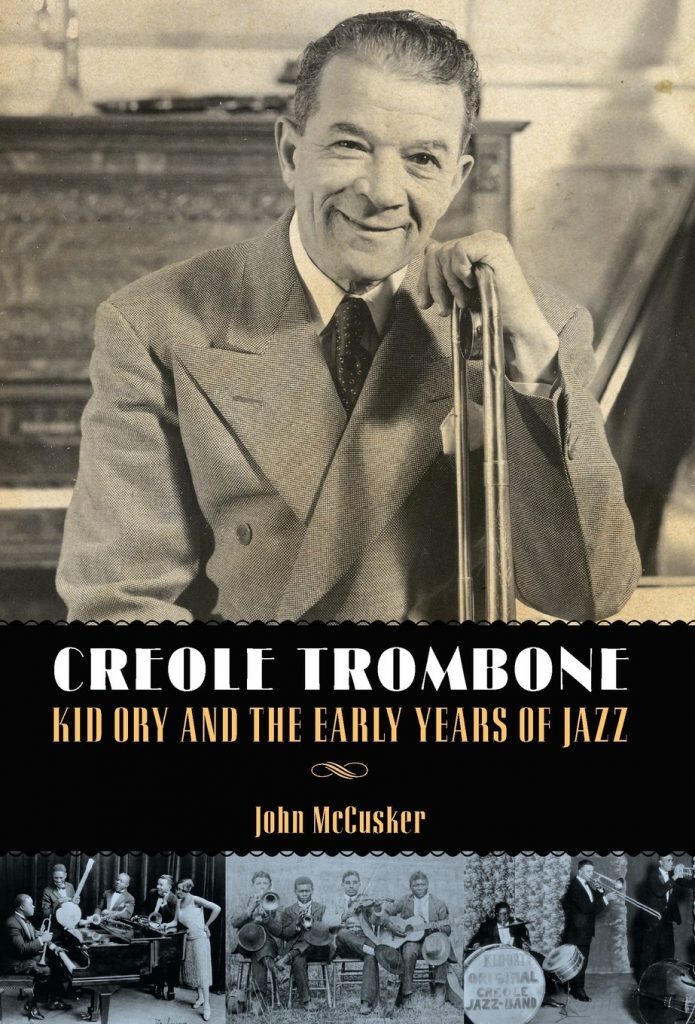 First released in hardcover back in 2012, we are using the occasion of a paperback edition to bring attention to John McCusker’s exciting biography of Edward “Kid” Ory. In under 200 pages it follows Ory through several rural Louisiana locales into New Orleans, then off to the West Coast in 1919, and later to Chicago where in several years as a sideman he would be part of the most seminal recordings in jazz.
First released in hardcover back in 2012, we are using the occasion of a paperback edition to bring attention to John McCusker’s exciting biography of Edward “Kid” Ory. In under 200 pages it follows Ory through several rural Louisiana locales into New Orleans, then off to the West Coast in 1919, and later to Chicago where in several years as a sideman he would be part of the most seminal recordings in jazz.
McCusker is a reporter and he brings a reporters mindset to the story. After years of investigation, he has the good sense to avoid including every little thing and instead spins a nuts and bolts tale you will remember. He drops you into the 1890s rural plantation life of Ory’s youth and the teeming streets of turn of the century New Orleans. The days before TV and AC when public parks bubbled with live entertainments.
Ory’s tale begins with him and a musically ambitious group of teenagers making their own instruments and playing wherever they could. This band of friends gradually improves until they can acquire ready-made instruments. Ory starts with banjo and eventually settles in on trombone as the hot music around him shifts from strings to brass. On trips to New Orleans, he watches idol Buddy Bolden and other early hot bands play around town. When his own band is ready they move into the city playing everywhere from brothels to society balls.
Despite being full of detailed information the book reads like a fairytale. As a teenager Ory buys a lot by saving his plantation wages and then builds a house on it with timber fronted by his next employer at a mill. In another entrepreneurial flourish, he begins to rent out dance halls for his band in the 1910s and he claims to have rented neighboring halls as well- to keep empty for the night so they wouldn’t have competition. Despite these early ventures, and his being a bandleader for most of his life, he misses a major windfall. He doesn’t begin to collect the royalties for “Muskrat Ramble” until the 1940s when his oversight is brought to his attention by a friend.
The use of Ory’s own narratives from his unfinished autobiography, and as he told them to others, gives events a polish that might be doubtful in some particulars but does convey his story. Where recollections are easily contradicted McCusker politely corrects the record. His approachable writing makes this an easy biography to read while also being a fascinating glimpse at the several cities that mark the timeline of Ory’s early career.
This book should be assigned reading for high school courses. Ory’s personal story is also the story of the early history of jazz. He was truly there from the dawn- crossing paths with Buddy Bolden, naming “King” Oliver, giving Louis Armstrong some of his first gigs, and recording the first jazz records made by a “Colored Band”. From the far perspective of Los Angeles and Oakland, after his move in 1919, it becomes easier to see how jazz was shaping the musical landscape in those earliest years. It is truly astounding to read the lineups of these early bands, men who nearly all would go on to become legends.
Once he reaches Chicago the book turns to the recordings of Kid Ory as a sideman. The great Louis Armstrong’s Hot Five sessions, particularly those cuts on which Ory shines, are discussed, as well as his work with Jelly Roll Morten, King Oliver, and others. This is his true importance musically and McCusker attempts to describe why in non-technical terms. He defends Ory against those who compare him to the wizardry of later soloists and find him lacking. Ory was at heart an ensemble player and even in the late 20s a bit of a throwback. For that reason, we are fortunate to have him on so many records, a glimpse at the pre-recording style of New Orleans trombone.
Ory’s unpublished autobiography cuts out in 1933 when Ory leaves music for a period and works as a janitor in the offices of the Santa Fe Railroad. This biography told, “in his voice”, also leaves things off there. The last 40 years of his life, including a second successful music career in the revival period, are given only five pages. But that period is covered in the guided discography included in the appendices, which also include unpublished compositions and two short excerpts from his autobiography.
If you want an easy way to catch up on the early years of jazz you could do no better than Creole Trombone.
Creole Trombone: Kid Ory and the Early Years of Jazz, by John McCusker
HC/PB 272 pages; 2012; ISBN-13: 9781617036262
Published to University Press of Mississippi: March 2014
Also read Scott Yanow’s Profile of Kid Ory, and the Red Hot Jazz Archive entry Kid Ory (1886-1973).
Joe Bebco is the Associate Editor of The Syncopated Times and Webmaster of SyncopatedTimes.com





















